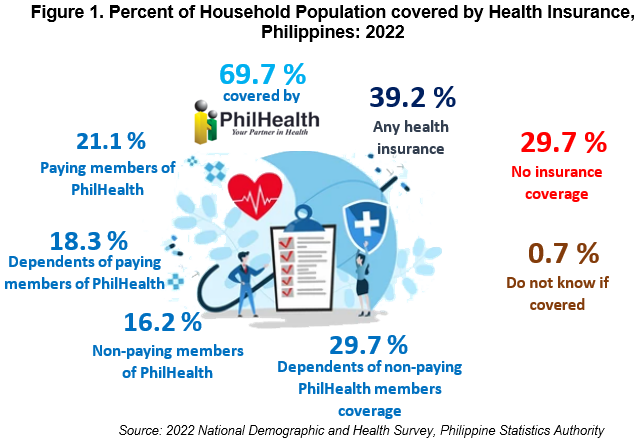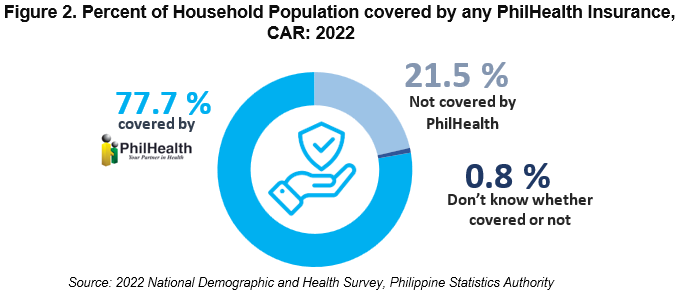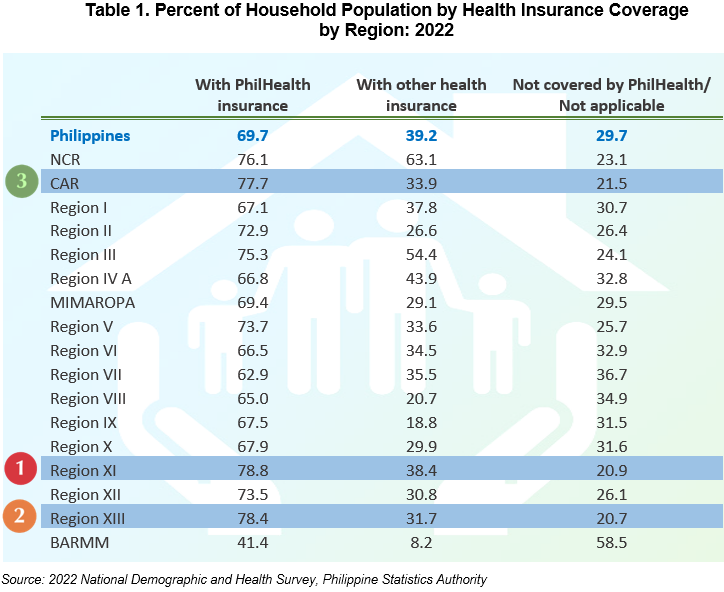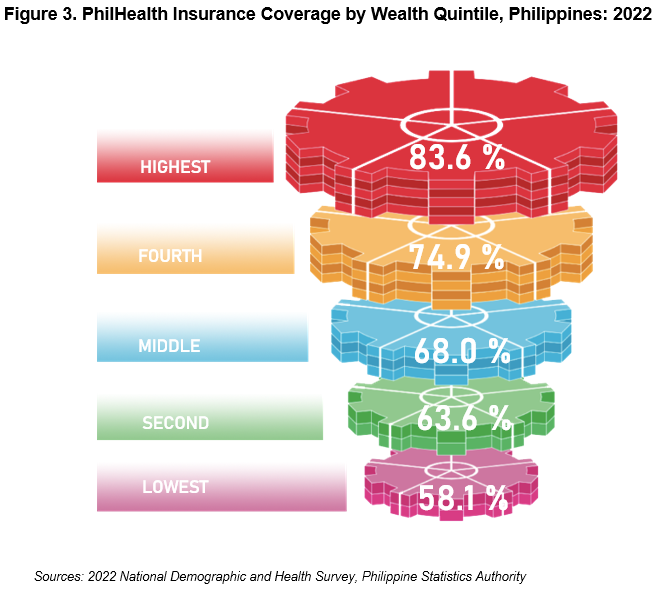Data on health indicators presented in this special release were obtained from the results of the Key Indicators Report of the 2022 National Demographic and Health Survey (NDHS). The 2022 NDHS is the seventh Demographic and Health Survey (DHS) conducted in the Philippines in collaboration with the worldwide DHS program, and the 12th in a series of national DHS conducted every five years since 1968.
The 2022 NDHS provides information on the basic demographic and health indicators, specifically on fertility, fertility preferences, family planning practice, childhood mortality, maternal and child health, nutrition, knowledge, and attitudes, regarding HIV/AIDS, violence against women, child discipline, early childhood development, and other health issues. These indicators are crucial in policymaking, program planning, and monitoring and evaluation of population and health programs, including those related to the Sustainable Development Goals (SDGs).
70% of Philippine household population are PhilHealth members
In 2022, 69.7 percent of households in the country were covered by Philippine Health Insurance Corporation or were members of PhilHealth, without regard to the type of coverage.
About 21.1 percent were paying members of PhilHealth with 18.3 percent of the household population as dependents, while 16.2 percent were non-paying members with 0.7 percent dependents.
Meanwhile, 39.2 percent of the household population was covered by any other type of health insurance.
On the other hand, 29.7 percent of the household population was not covered by any health insurance.
About 0.7 percent do not know whether or not they were covered by any health insurance.

78% of Cordilleran households are covered by any type of PhilHealth insurance
In the Cordillera Administrative Region (CAR), 77.7 percent of the household population were covered by PhilHealth insurance of any type where 19.3 percent were paying members with 20.4 percent dependents. About 20.7 percent were nonpaying members with 17.4 percent dependents.
About 33.9 percent of the household population of CAR was covered by any other type of health insurance.
On the other hand, 21.5 percent of households do not have any health insurance, and about 0.8 percent do not know whether or not they were covered by any health insurance.

CAR ranks third among regions with highest number of households with PhilHealth coverage
Among regions, Region IX - Davao ranked first with the highest percentage of the household population covered by PhilHealth with 78.8 percent, Region XIII - CARAGA ranked second with 78.4 percent and CAR ranked third with 77.7 percent.
The other regions with 70.0 percent and above of the household population with PhilHealth insurance were NCR with 76.1 percent, Region III - Central Luzon with 75.3 percent, Region V - Bicol with 73.7 percent, Region XII -SOCCSKSARGEN with 73.5, and Region II - Cagayan Valley with 72.9 percent.
The region with the lowest household population covered by PhilHealth insurance was BARMM with 41.4 percent.

PhilHealth insurance coverage is highest among rich household population
By wealth quintile, the rich households in the Philippines had the highest percentage of population with PhilHealth insurance coverage (83.6 percent). .
In general, PhilHealth coverage increased among households with increasing wealth, from 58.1 percent in the lowest wealth quintile to 83.6 percent in the highest quintile.

(SGD)
VILLAFE P. ALIBUYOG
Regional Director
_____________________________________________
TECHNICAL NOTES
Health insurance – is an agreement in which an insurance company agrees to pay for some or all medical expenses in exchange for a monthly premium payment.
PhilHealth – is the government agency that provides health insurance coverage for all Filipinos and ensures affordable, acceptable, available, and accessible healthcare services for all citizens of the Philippines.
Wealth Quintile - Households are given scores based on the number and kind of consumer goods they own, ranging from television to a bicycle or car, and housing characteristics such as the source of drinking water, toilet facilities, and flooring materials. These scores are derived using principal component analysis. National wealth quintiles are compiled by assigning the household score to each usual (de jure) household member, ranking each person in the household population by her or his score, and then dividing the distribution into five population categories, each comprising 20% of the population.

